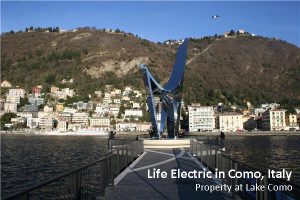
Libeskind on Lake Como
As of October 1st, 2015, there is a new work of art on display on Lake Como’s breakwater. It has been created by the Polish-American architect Daniel Libeskind, one of the world’s most important architects, and donated to the city of Como. The work (see picture) has raised both enthusiastic and negative comments, as often happens anywhere in the world when it comes to contemporary art.
Why is it that so many contemporary art expressions tend to provoke such radical reactions? And not only: looking at this art work by Libeskind – so unpredictable, stimulating and highly creative – it is natural to ask ourselves what is the role and function of art, although the question “what is the use of art” usually causes awkward answers, if not total silence. It is almost as if people are afraid of not giving the “right” answer, one that instinctively we all know. According to Swiss writer and philosopher Alain de Botton, art helps us to live a better life, to be happier thanks to a contemplation of beauty. Others believe that art is the most powerful inspiration of our thinking, an engine that activates our ability to ponder about life and the reality around us. And therefore about the human being, his nature and destiny.
What is Daniel Libeskind’s own opinion? When asked about how his projects are born, especially the recent one he realized for the Expo in Milan, his answer is: “I listen to stones. I gather the faces around me. I try to build bridges toward the future looking at the past with clear eyes. I am inspired by light, by sound, by invisible spirits, by the clear consciousness of the place and respect for history”.
On the occasion of the “Life Electric” monument inauguration, Libeskind was asked: Why Como, architect? “I fell in love with Como and I am honored to have been offered the opportunity to create something important for the city, something that will belong to its heritage and its future”. The work is dedicated to Alessandro Volta, who held the office of waterway Manager for the Austrian administration.
How can we interpreter this work? What is the tale of this 16,50 meter high monument with two counterposed sinusoids playing with each other between curves and motion? About its most authentic meaning, Daniel Libeskind again gives us his support: “Life Electric is inspired by electric tension between two poles of a battery, Volta’s great gift to humanity. The shape of the installation has its cornerstone in my constant research on the architectural representation of energy. The work connects the elements: light, wind and water. It is an installation, a physical and ideal gateway towards 21st century”.
Confidence in humanity. Perspective. Hope. Will of unveiling the secrets of nature. These are the principles of the “Age of Enlightenment” that led men such as Alessandro Volta to investigate, discover, invent: he was the inventor of the first power generator, of the battery and the discoverer of methane gas. “Fatti non foste per viver come bruti, ma per seguir virtute e conoscenza” said by Dante Alighieri’s Ulysses. Virtue and knowledge: then it is true that between science and art, between scientific research and artistic experimentation, the distance is not far.
